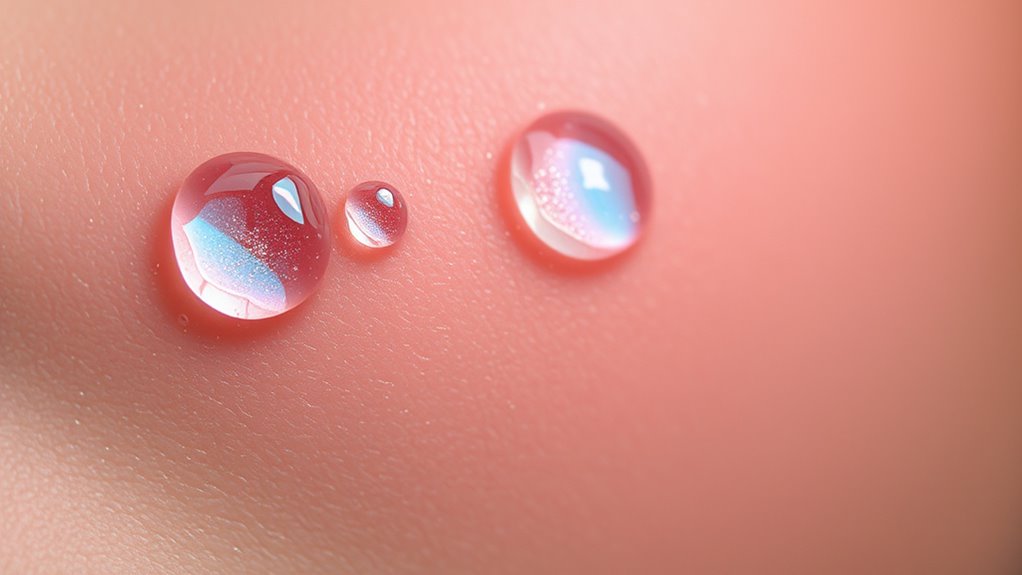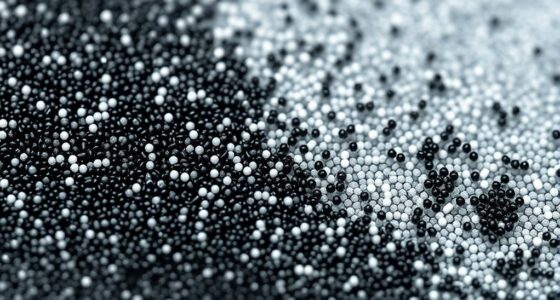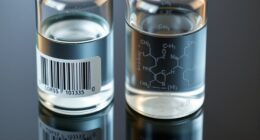Different types of tears serve unique purposes and have distinct chemical compositions. Basal tears keep your eyes moist and contain antimicrobial proteins, while reflex tears flush out irritants with immune molecules. Emotional tears, triggered by strong feelings, contain higher levels of hormones like prolactin and stress-relieving neuropeptides. Their special chemistry helps protect your eye health and manage emotions. To understand more about what makes each kind of tear unique, keep exploring these fascinating details.
Key Takeaways
- Different tears (basal, reflex, emotional) have distinct protein and chemical compositions tailored to their specific functions.
- Emotional tears contain higher levels of hormones and neuropeptides like prolactin and enkephalins, aiding emotional regulation.
- Reflex tears are rich in immune proteins such as lysozyme and immunoglobulins for rapid eye defense.
- The chemical makeup of tears varies across species, indicating conserved and specialized functions.
- Tears serve both protective and emotional roles, with their chemistry reflecting their unique biological purposes.
Types of Tears and Their Unique Roles
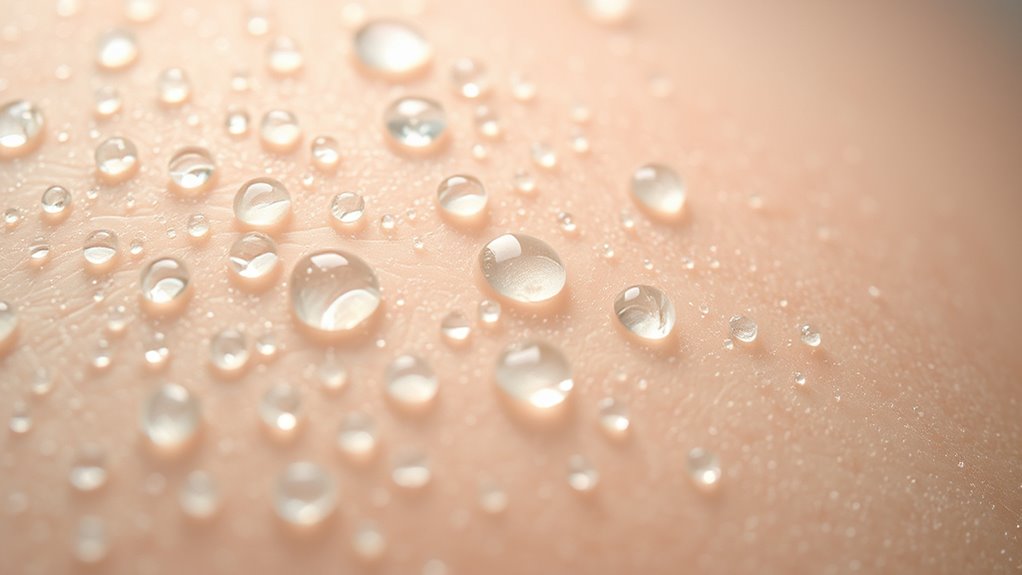
Tears are more than just emotional responses; they serve distinct functions based on their type. Basal tears keep your eyes moist and lubricated constantly. They form a protective film over your cornea, shielding it from dust, debris, and microorganisms, while also delivering essential nutrients and oxygen since the cornea lacks direct blood flow. Advances in AI in Education are also exploring how personalized learning systems can adapt to students’ emotional states, similar to how tears respond to feelings.
Reflex tears act quickly when irritants like smoke or wind strike your eye. They produce larger volumes to flush out harmful substances and contain higher levels of protective proteins to fight infection.
Emotional tears respond to strong feelings like sadness or joy. They contain unique chemicals, including stress hormones, which may help regulate your emotions by reducing stress and tension. Additionally, the air quality in your environment can influence the frequency and composition of your tears, especially reflex and emotional tears.
Each tear type plays a crucial role in maintaining eye health and emotional well-being.
Composition Differences Among Tear Types

The protein composition of tears varies considerably among different types, reflecting their distinct functions and physiological origins. You’ll find that basal, reflex, and emotional tears differ in protein concentrations and profiles, with closed-eye tears containing more serum-derived proteins due to conjunctival blood vessel leakage. Durability in toys can also be compared to the resilience of tear proteins, which maintain their protective functions over time. Immune-related proteins tend to be more abundant in reflex tears, supporting rapid defense against irritants. Human tears include lysozyme, lactoferrin, lipocalin, and immunoglobulins, each playing a role in antimicrobial defense and tear film stability. The variations in total protein content help adapt tears to specific needs—for example, certain proteins are more prominent in tears of animals adapted to aquatic environments. Human tears contain antimicrobial agents that are crucial for preventing infections on the eye surface. Additionally, the protein profiles of tears can vary significantly among different species, reflecting evolutionary adaptations. Horses, in particular, show protein compositions remarkably similar to humans, emphasizing conserved functional roles across mammals.
The Special Chemistry of Emotional Tears
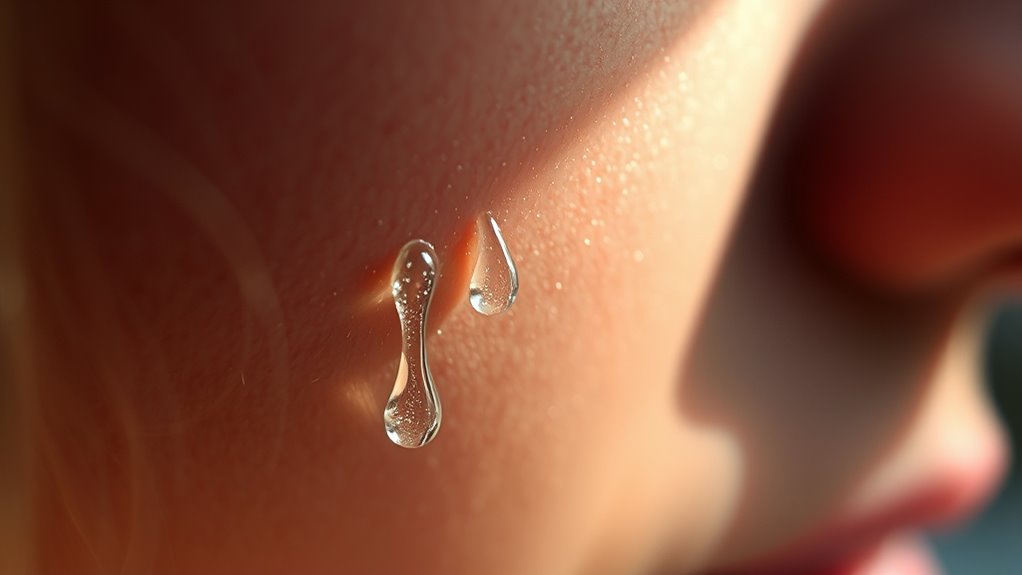
Among the different tear types, emotional tears stand out due to their unique chemical composition linked to feelings and psychological states. These tears contain higher levels of hormones like prolactin and adrenocorticotropic hormone, which are associated with stress and emotion regulation. They also have increased concentrations of neurotransmitters and neuropeptides, such as leu-enkephalin, potentially helping to reduce stress and restore emotional balance. The presence of stress-related hormones and neurochemicals suggests that crying may serve a biochemical purpose, releasing substances that help manage emotional intensity. Additionally, the composition of emotional tears varies considerably from that of basal or reflex tears, highlighting their distinct biological role. Electrolytes like potassium and manganese are elevated in emotional tears, emphasizing their distinct chemical makeup. The presence of stress-related hormones and neurochemicals suggests that crying may serve a biochemical purpose, releasing substances that help manage emotional intensity. These chemical differences provide insight into the complex relationship between emotions and physiology, and studying these tears offers insights into emotional processing and could have therapeutic implications for emotional health.
Biological Functions of Various Tears

Have you ever wondered how your eyes stay healthy and comfortable under various conditions? Your eyes rely on different types of tears to protect and maintain them.
Basal tears constantly lubricate the eye surface, preventing dryness, delivering oxygen and nutrients to corneal cells, and forming a barrier against irritants and microbes. They contain antimicrobial agents like IgA and lysozyme, helping fight infection.
Reflex tears respond to irritants such as dust or fumes, flushing out harmful substances and reducing inflammation.
The tear film, with its lipid, aqueous, and mucin layers, ensures proper hydration, minimizes evaporation, and promotes clear vision.
Together, these tears support immune defense, facilitate wound healing, and keep your eyes comfortable and healthy in everyday life.
How Artificial Tears Compare to Natural Ones
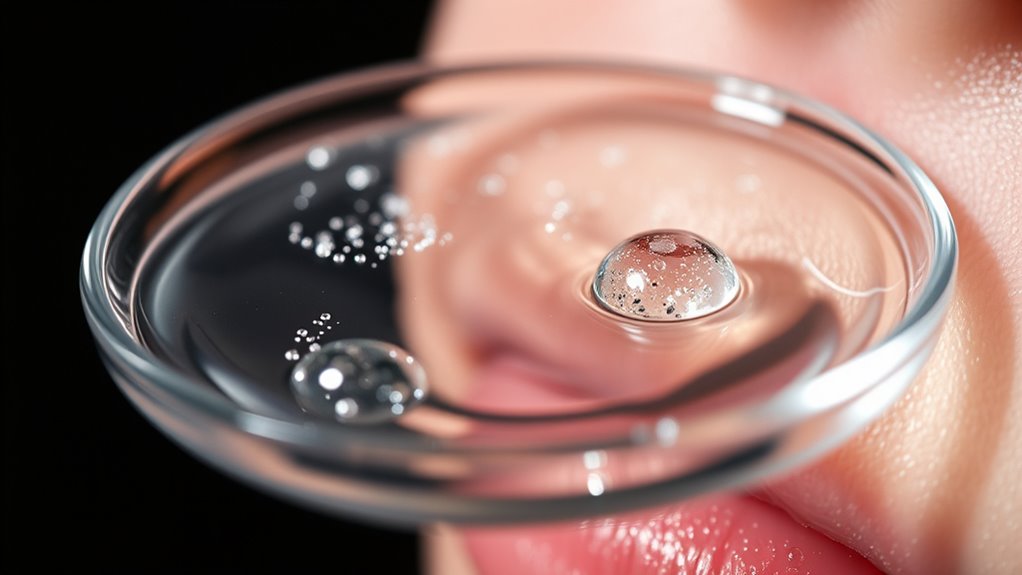
Artificial tears are designed to replicate the primary functions of natural tears, mainly providing lubrication and hydration to relieve dryness. They contain ingredients like glycerin, carboxymethylcellulose, polyethylene glycol, and hyaluronic acid, which mimic the hydration and lubricating effects of the aqueous layer. Hyaluronic acid, in particular, binds water and promotes epithelial cell health, while trehalose offers additional protection for corneal cells. However, artificial tears lack the full complexity of natural tears, including nutrients, growth factors, and immune components that support ocular health. Advanced formulations with shear-thinning properties mimic natural tear rheology, improving comfort. Still, they don’t fully replicate the lipid and mucin layers, which help stabilize the tear film and prevent evaporation. Additionally, the integration of neural networks in AI tech is enhancing the development of personalized ocular treatments, leading to more targeted and effective therapies for dry eye sufferers. These innovations aim to better emulate the complex composition of natural tears for improved patient outcomes.
Microscopic Signatures of Different Tears
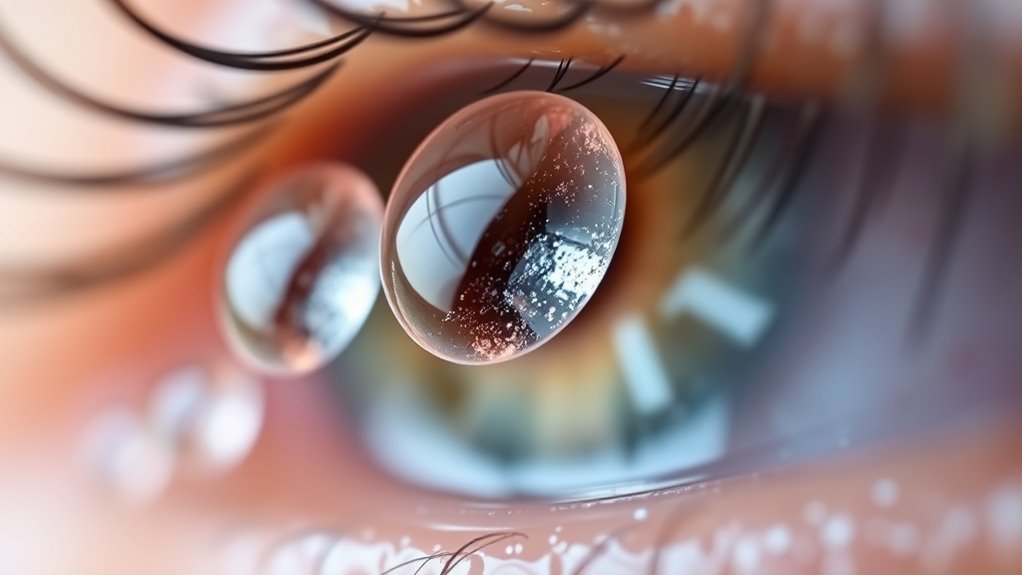
Tears exhibit distinct microscopic signatures that reflect their specific functions and origins. When you examine dried tears under a microscope, you notice unique patterns resembling terrain landscapes. Emotional tears show heterogeneous structures with varying regions and no uniform pattern, indicating complex compositions.
Reflex tears tend to form simpler, less protein-dense crystalline structures, often with more salts and water to quickly flush irritants. Basal tears, which keep your eyes lubricated, produce more uniform, stable patterns with oils, enzymes, and antibodies.
The chemical makeup influences how tears crystallize after drying. Factors like drying method, tear volume, and individual variation also shape the microscopic appearance. These microscopic signatures act as biological fingerprints, revealing subtle differences linked to emotional and physiological states.
The Stress-Relief and Pain-Reducing Properties of Tears

Crying serves as a natural mechanism for stress relief and pain reduction, actively releasing chemicals that help restore emotional and physical balance. When you cry, your tears release stress hormones like prolactin and endorphins such as leucine-enkaphalin, helping lower stress levels. This chemical elimination supports emotional equilibrium after tough moments.
The act of crying also triggers the release of endorphins, which are your body’s natural painkillers, and oxytocin, which boosts feelings of well-being and reduces pain. Emotional tears contain higher levels of stress hormones, manganese, and proteins, aiding in toxin elimination.
Suppressing tears can increase stress and create emotional blockages, negatively impacting your health. Crying, thus, acts as an essential emotional outlet, relieving stress and alleviating both physical and emotional pain.
Practical Uses of Tear Analysis in Medicine

Tear analysis has become a valuable tool in medicine due to its ability to provide non-invasive, rapid insights into both ocular and systemic health. You can use tear fluid biomarkers to accurately diagnose conditions like dry eye disease, with markers such as S100A6 and annexins offering over 94% sensitivity and 97% specificity.
Multiplex assay technologies, like cytometric bead arrays, enable simultaneous detection of multiple cytokines, improving inflammatory profile assessments. Tears can distinguish between related conditions, such as dry eye and meibomian gland dysfunction, with about 73% accuracy.
Additionally, tear biomarkers help monitor systemic diseases like diabetes, multiple sclerosis, and even cancer. This non-invasive sampling allows for repeated testing, personalized diagnostics, and real-time tracking of disease progression and treatment efficacy, making tear analysis a powerful clinical tool.
Frequently Asked Questions
Can Emotional Tears Be Used to Diagnose Mental Health Conditions?
You might wonder if emotional tears can diagnose mental health issues. While they can signal emotional distress, they aren’t reliable on their own for diagnosis.
Mental health conditions require a detailed evaluation by professionals who consider symptoms, history, and behavior.
Emotional tears are just one possible indicator, but accurate diagnosis depends on thorough assessments and understanding the underlying causes, not just crying episodes.
Do Tears From Different Emotions Have Distinct Healing Properties?
You might wonder if tears from different emotions offer unique healing powers. While tears of sadness help release stress and emotional pain, tears of joy boost happiness through oxytocin.
Empathy tears strengthen bonds, and relief tears flush out stress hormones. Each emotion’s tears serve a distinct purpose, promoting emotional recovery and social connection.
How Do Tear Compositions Change With Age or Health Status?
You should know that as you age or experience health issues, your tear composition changes markedly.
The stability of your tear film decreases, making tears more prone to evaporation and damage.
Inflammatory mediators like IL-6 and IL-8 increase, indicating heightened inflammation.
Protein levels shift, especially those involved in tissue remodeling, which can worsen dry eye symptoms and affect ocular health.
These changes can serve as markers for diagnosing and managing age-related eye conditions.
Are There Any Risks Associated With Analyzing Tear Biomarkers?
Risks in analyzing tear biomarkers are like traversing a delicate tightrope. You might face challenges like infection if hygiene isn’t maintained, or irritation from invasive collection methods.
There’s also the danger of misinterpreting results due to equipment sensitivity or variability in biomarkers. Environmental factors and lack of standardization can cloud accuracy.
Staying vigilant about these risks guarantees your research remains safe, reliable, and ethically sound.
Can Artificial Tears Be Engineered to Mimic Emotional Tear Chemistry?
You wonder if artificial tears can be engineered to mimic emotional tear chemistry. While current formulations mainly focus on lubrication and hydration, future advancements could include bioactive molecules like hormones and proteins unique to emotional tears.
Research into tear biochemistry and stimulus responses might enable you to develop artificial tears that simulate emotional tear components, potentially expanding their role beyond mere lubrication to more complex emotional and biochemical functions.
Conclusion
By understanding the unique chemistry of tears, you gain insight into how they serve as your body’s silent language—each drop telling a story. Whether it’s the joyful shimmer of happiness or the quiet ache of sorrow, tears are your emotional compass and biological shield. Think of them as tiny messengers, painting your feelings in delicate, invisible strokes. Embrace their power, for in every tear lies a story waiting to be heard.
